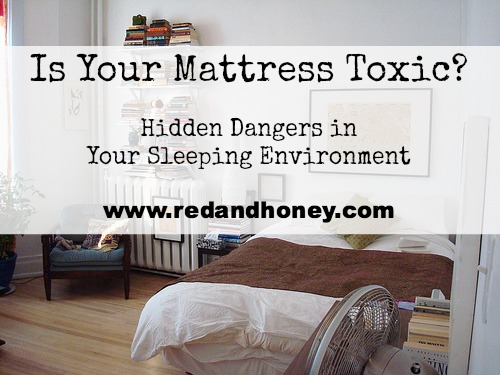
(Hold on to your hats, kids – this is a long one!)
How many hours of your life do you spend in your bed?
(Well, you take the number of children you have, divide it by the square root of fussy teething nights, subtract the nightmares, the bedwetting and the stomach flu, then you divide by eleventy billion. So you have like eight and a half whole minutes in your bed every night. Oh wait…)
If you get an average amount of sleep, you spend around 8 hours in bed each night. 56 hours a week. That’s around one third of your entire life.
That’s a lot.
Logic would dictate that we would desire a healthy and toxin-free spot to rest our weary heads each night, but unfortunately that can be difficult to find.
Our family recently took steps to make our sleeping environments safer. In my quest to figure out the very best and safest mattress and bedding set-up possible, I waded through a ton and a half of heavy research and was left with a zillion questions. Eventually, I began to slowly get a handle on the issues. Here is a summary of my thoughts on the issue, and the solutions we put into place in our family.
Part 1: What’s the Problem?
Conventional mattresses are pretty much full of nasty, toxic chemicals and made of materials that are linked to a huge list of serious health complications including SIDS, asthma, allergies, reproductive toxicity, respiratory problems, skin irritations, cancer, and more.
Here’s a list of some of the worst materials used in conventional mattresses:
- Polyurethane foam (petroleum-based material that emits VOC’s)
- Formaldehyde (linked to asthma, allergies, and lung cancer)
- Flame retardants (linked to cancer and nervous system disorders) such as PBDE’s, which were very recently banned in many countries. Unfortunately that’s not much help since other equally toxic chemicals are easily used instead, without any real regulation for health hazards.
- Boric Acid (roach killer)
One article I read states: “In 2005, Walter Bader, owner of the “green mattress” company Lifekind and author of the book Toxic Bedrooms, sent several mattresses to an Atlanta-based lab. A memory-foam model was found to emit 61 chemicals, including the carcinogens benzene and naphthalene.” (source)
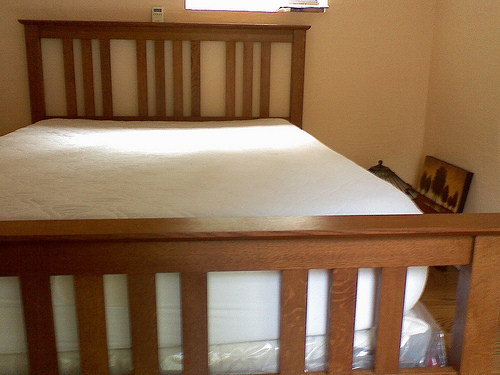
(image source)
Despite what some believe, it’s not a crazy hippie conspiracy theory and its not a load of unfounded, unproven claims, either.
The same governments that enacted mandatory flame-retardant laws in the sixties are now passing new laws banning the use of PBDE’s (polybrominated diphenyl ethers) in mattresses, and they are being phased out of other products as well (they are in lots of things like electronics, furniture, textiles, etc).
This article states that “growing evidence shows that PBDE compounds are escaping from the products they protect and making their way into the products’ users. Moreover, the chemicals may disrupt human thyroid hormone functioning and cause other health effects, prompting many nations to ban or suspend their use in new consumer goods.” (source)
The problem is that this newfound “revelation” by the government (it was about time!) is that it has only been in the last five years or so. Unless you have a mattress newer than that, it most likely contains PBDE’s.
So if I buy a new mattress, I’m in the clear then? Unfortunately not. That would be way too easy, right? It’s not like the new flame-retardants are going to be any better. There’s a reason they won’t give you a straight answer at the local conventional mattress store when you ask about what kinds of flame retardants they use. All they know is that they pass the flammability tests. They don’t necessarily care how.
Whether you’re sick now or whether you won’t feel the effects for another decade, the fact is that mattresses are made with horribly noxious materials that have been proven to negatively affect human health. In my mind this is perhaps the greatest natural health issue we face today.
Part 2: Are Flame-Retardants Legally Required?
In the sixties, the government passed into law that all mattresses must pass a flammability test for safety reasons in case of fire in the home. Good intentions, perhaps, but the method for carrying this out has presented an unacceptable level of danger in itself. These flame-retardants are the biggest source of concern to me.
Companies use a variety of toxic harmful substances to pass these flammability tests. All involve dangerous chemicals that have been directly linked with a host of serious health complications, such as were described above. What good is saving your house from burning down if you’re breathing in toxic chemicals every night as you sleep?!
Banning certain toxic chemicals is great, but that doesn’t help the countless products already in peoples’ homes, emitting toxic gasses. The flame-retardant law still stands, and companies must figure out how to meet the requirements.
(Fortunately, there are a few different ways that naturally-minded companies meet this requirement, which I will discuss further below.)

(image source)
There are a few voices of reason amidst the clamour (although they are sadly not the ones in charge!). Arlene Blum, a biophysical chemist and visiting scholar at the University of California, Berkeley says:
“Instead of adding new fire retardant chemicals that ultimately may be shown to cause health problems, we should be asking whether we need to use these chemicals or if there are other ways to achieve equivalent fire safety. So many of the chemicals we have banned in the past were flame retardants—think about asbestos, polychlorinated biphenyls, polybrominated biphenyls, tris(2,3-dibromopropyl) phosphate, PBDEs—[and] they all ended up in the environment and in people. We need to think carefully about adding these sorts of chemicals to consumer products before there is adequate health information.” (source)
Part 3: Healthy Options Do Exist!
I don’t know about you, but as a mama bear to three beautiful little people, this whole issue makes me angry. Why should mattress companies (and other product manufacturers too!) be allowed to make and sell things with terribly harmful materials?
Why did it take me hours and hours of wading through medical journals and online research to figure out how to give my kids a safe place to pay their heads at night?
This is just not right.
The only real solution I can see is to opt out. As far as finances will allow, choose to opt out of the system in which consumers are taken advantage of and deceived. Choose to buy from companies that you trust to use natural, non-toxic materials that won’t harm the environment or you. Choose to be educated on the issue, and if money is tight, then do the best you can with what you have.
Beware of companies that throw around the words “natural” and “organic” without explaining and defending those claims. A company worth your business will be able to tell you exactly where the materials came from (and what the materials are), what happened to them before they reached the factory, and how the mattress was made.
A mattress can legally be called organic if it contains any organic component such as an organic cotton filling or even just an organic cotton surface fabric. Some organic mattresses have organic cotton filling with a vinyl covering. These may be called organic mattresses, but because of the vinyl covering and chemical fire retardants, these mattresses are obviously not all that healthy.
There are companies that sell mattresses that are completely natural and toxin-free. Organic wool has natural fire-resistant properties and is a natural material that is used successfully in mattresses to pass the flammability tests.
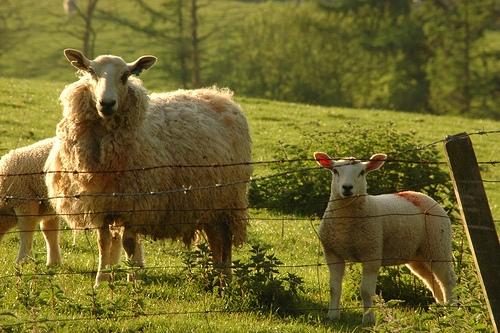
(image source)
The other materials in the mattress are important too. Organic cotton is important, as cotton in one of the most heavily-sprayed crops. A good company will be upfront about the materials they used.
If the mattress is all natural and organic, you can bet your bottom dollar that they will loudly proclaiming it! Ask questions. Ask how they pass the flame-retardant test, ask where they get their materials. Ask anything and everything, and expect honesty and forthcoming answers. Anything less? Walk away.
Part 4: Our Family’s Solution (A More Frugal Option)
Firstly, I ordered several items from The Good Planet Co. in British Columbia, Canada. They ship their mattresses for free in North America, and they have absolutely incredible products and equally amazing service. There are other online retailers that may be equally as great – this is just the one with which I personally have experience.
When I called them with my many questions, Alain (a co-founder of the company) told me that one of the sources for their organic wool is Texel Island, Netherlands, where it is simply washed with a vegetable-based soap after shearing, before being sent to the factory in Ottawa, Canada, where the mattresses are made. There are no secret treatments or chemicals added at any point in the process. No toxic chemicals emitting fumes inches from your nose as you sleep. Just pure, natural materials packaged together in a quality mattress.
(Alain told me that their factory is so strictly anti-toxins that their workers are not even allowed to wear scented deodorant! Impressive, I’d say!)
When presented with a financial gift last year we made the decision to take steps to detox our family’s sleeping environments. We bought an organic crib mattress for the baby, who was 4 months old at the time. He’ll sleep on that until toddlerhood.
Since we could not actually afford to buy ourselves a full organic mattress as well, we decided to go with a more affordable option that we’d heard about from a friend: mattress wrapping. I researched it and was convinced that it is a solid option for those who don’t necessarily have thousands of dollars to spend on a queen-sized organic mattress, but are desiring to not breathe in the toxic chemicals all night long. The basic idea is to wrap your conventional mattress in high-grade non-toxic polyethelene plastic, which is impermeable to gasses, thus preventing you from breathing them in.
We also initially wrapped a conventional crib mattress for Canaan before ordering him an organic one. We got our crib mattress wrap from this website from New Zealand for a cost of $40, including shipping. Way cheaper than an organic mattress for sure, and a much safer option than throwing your hands up in frustration and doing nothing.
For the older two kids (aged 2 and 4) we purchased mattress wraps from the same site as ours, and topped them with a Happy Lamb Fleece Topper for comfort (available at Good Planet Co by phone order – not currently listed on their site).
We also bought organic pillows for each of us in a variety of styles according to preference. I love my kapok pillow!
A Final Word
Our solution was a mix of various options. We tried our best to spend the money where it mattered most, and I think we did a pretty decent job. If we hadn’t been blessed with a financial gift, we most likely would have simply figured out a way to purchase the mattress wraps for all of us and been content with that.
Making your sleeping environment safer doesn’t have to break the bank. Sure, organic everything would be nice, but not many of us can afford that. Perhaps there’s a different solution that might work for you too.
Have you considering detoxing your sleeping environment?
This post is Week Two of the Raising Healthy Families series in which I am participating. This was my week. If you’re not a usual reader around here, welcome! Take a second to like Red & Honey on facebook, or subscribe using the options in the sidebar. I’d love to see you again!


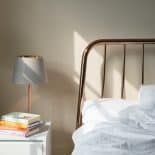



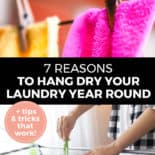

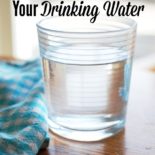

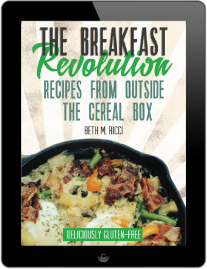

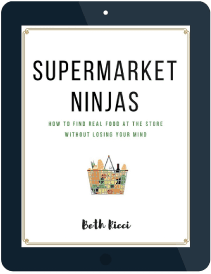
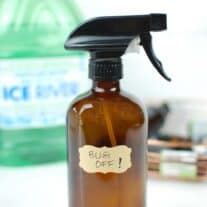

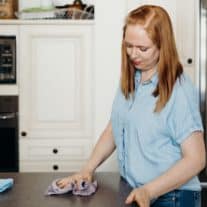




Jane MacCutcheon
My understanding of Borax is different. It is toxic to pests, but not to humans in carefully used amounts. Indeed, it can be used internally as a treatment – of course one must know how much and be very careful in its usage, following protocol – no one please decide to use it without knowing the very specific way to use it from a qualified source! It is a preferred insect treatment over pesticides as it is not toxic to us in the way it is to pests, indeed, they dislike it. I sprinkle it around the inside of the unfinished closed off alley next to our finished basement area and around the house. I have no fear of it. It is excellent to keep out pests. And yes, boron, it’s chief toxic ingredient is in the old fashioned Harris roach tablets along with an enticing “lure,” which I suspect is a sugar of sorts. It is used in non-toxic house insulation as well as for pest control.
This is from this source: http://sci-toys.com/ingredients/borax.html
This is what Borax is: Synonyms: Sodium borate decahydrate, Sodium tetraborate decahydrate, Sodium biborate, Sodium pyroborate
Borax is used in laundry detergents and bleaches. It releases hydrogen peroxide when it reacts with water. Hydrogen peroxide acts as a bleach, and this action is aided by the alkaline solution also produced by the reaction.
Borax is a good buffer, helping to keep the acidity or alkalinity of a solution stable.
The boron (along with the oxygen and salt) in a borax solution helps to disinfect by killing bacteria and fungi.
Ellie
This may be an old post, but still very timely. Being bombarded by so many toxins on a daily basis, it’s pretty important not to have to be subjected to them in our sleep. It’s good to know that there are natural options for fire retardants. Wrapping your mattress was an intriguing idea as well. Awesome, frugal idea :-).